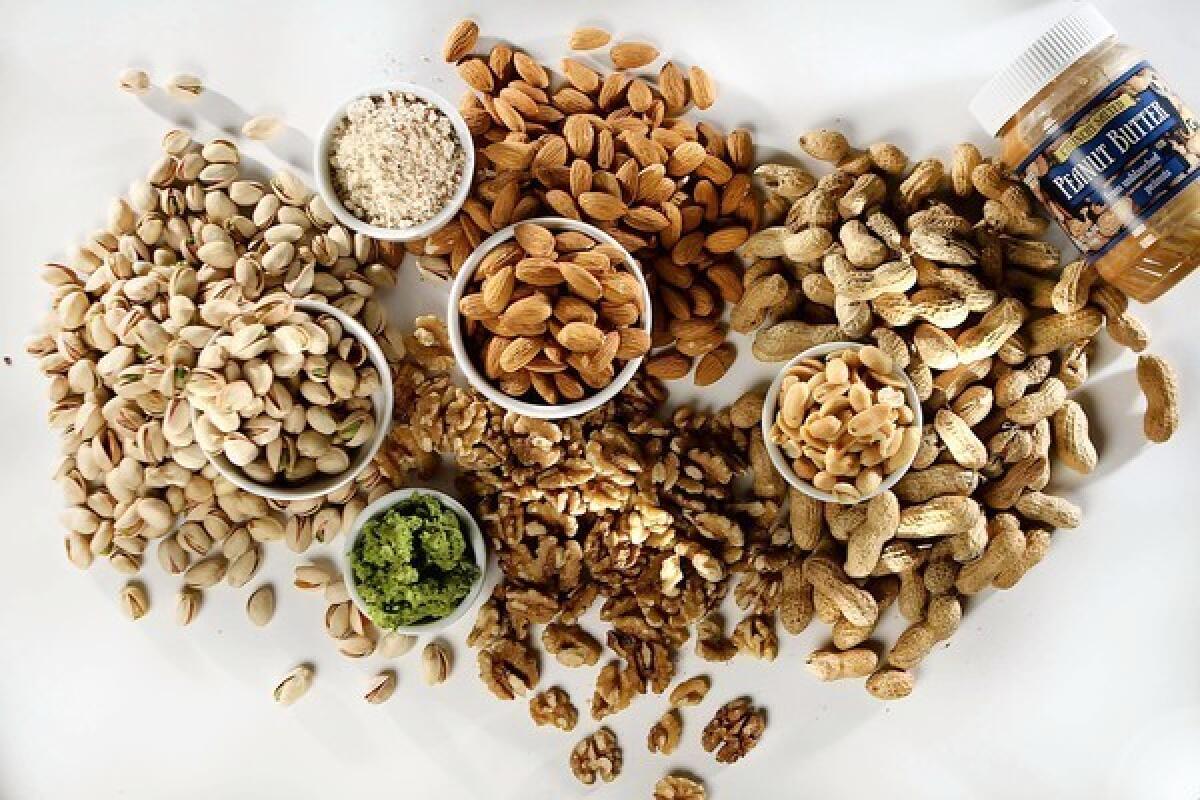Why more people are going nuts for nuts

Dieters used to shun that little bowl of salted and mixed nuts at parties — too fattening, they’d say. But nuts have moved beyond the cocktail crowd. They’re an economical source of protein being used in every course of the meal for all kinds of eaters: as flour for the gluten-averse, milk for the lactose-intolerant and even as a snack for people watching their fat intake.
Only a few decades ago, many doctors and nutritionists warned that nuts should be eaten on special occasions and even then only sparingly. Nuts were grouped with high-fat snacks such as potato chips and crackers in the era of low-fat diets in the 1980s, explained Dr. David Heber, director of the UCLA Center for Human Nutrition. The high-calorie content of fat in nuts motivated dieters to avoid them. But since that time, a more balanced view of how to eat has emerged.
“I like to say the setting in which you eat nuts matters,” Heber said. “In the 1970s, a cup full of nuts, a double scotch and a big prime rib is the wrong setting. While wearing an exercise outfit, emerging from the gym and having a 2-ounce serving, along with a low-fat diet rich in fruits and vegetables, is the right setting.”
And as vegetarianism grows, nut consumption grows too.
“Nuts give vegans and vegetarians a great base for protein,” said Roi Elam, sous-chef at Sun Cafe, a Los Angeles raw food and vegan restaurant.
Cashews and pine nuts offer a creamy consistency, and nuts are a good binder for crusts and pastas, he said.
Nut crops have spiked too. According to the U.S. Department of Agriculture, 800 million pounds of almonds were produced in the U.S. in 2001-02; that had doubled by 2010-11. Walnuts and pistachio production nearly doubled too, according to the USDA.
Nearly every type of nut has nutritional value, although some have more heart-healthy benefits than others, experts said. Nuts have been associated with lowering LDL, or “bad,” cholesterol, and experts say the unsaturated fats likely have a hand in that. Nuts also contain a high amount of omega-3 fatty acids, which have been shown to prevent irregular heart rhythms that can lead to heart attacks.
And in 2003, the U.S. Food and Drug Administration authorized a health claim for particular nuts, including walnuts, almonds, peanuts, pine nuts, hazelnuts and pistachios, that allowed labels that say scientific evidence suggests but does not prove that eating 1.5 ounces per day of most nuts as part of a diet low in saturated fat and cholesterol may reduce the risk of heart disease. The government excluded cashew, macadamia and Brazil nuts because of their higher levels of saturated fats.
Connie Diekman, director of university nutrition at Washington University in St. Louis, said studies in recent years have been able to better assess the nutritional content of nuts, leading to a better understanding of the fat in nuts.
In 2009, the National Institutes of Health looked at walnuts’ effects on people with diabetes. Researchers found the participants who ate walnuts felt full without an effect on their insulin levels. And other researchers are looking at that sense of fullness and how it affects health and weight.
“Studies continue to assess the role of nuts in health, from working to understand how they impact satiety to [whether] all the calories they contain are actually absorbed,” Diekman said.
“While high in calories, [nuts] can actually help control [and] reduce total calorie intake, and therefore, weight,” said Dr. David Katz, director of the Yale Prevention Research Center. “One hundred-calorie packs of junk food, not so much.”
Here’s a look at some of the healthful nuts, with data provided by the USDA. All the nuts can be eaten raw or roasted, as well as in other forms. A 1-ounce serving is about one-quarter cup.
Almonds
Almonds are indigenous to the Mediterranean region of the Middle East, but California also is a major producer. They are often made into butter, paste, milk or oil. One of the most popular nuts among health gurus, almonds are high in vitamin E, fiber and potassium.
“These nutrient-rich foods can provide a good package of healthfulness in a very portable form,” Diekman said.
Studies have shown that almonds can help reduce triglyceride levels in the blood, Heber said.
Calories per ounce: 163
Total fat per ounce: 14.01 g
Fiber: 3.5 g
Protein: 6.02 g
Peanuts
Though classified as a nut by the FDA, peanuts are legumes in the botanical world. Portuguese explorers introduced the peanut to China in the 17th century, and China is now the largest peanut-producing country in the world.
Peanuts are often boiled or dry-roasted, and they can be found in the form of butter, flour, milk and oils. Paints, furniture polish and varnish are also made from peanut oil. Peanuts are rich in niacin, fiber and magnesium, and they contain more protein than any other FDA-classified nut, according to the USDA.
But read the label on peanut butter jars; Heber noted that nut butters can be high in calories and should be used with the least amount of naturally occurring fat as possible.
“Most nuts are equally good for you with the exception of oiled-, sugared- [or] candied nuts, which have more calories and should be regarded as candies,” Heber said. “Avoid any nut butters with added vegetable oils or lard.”
Calories per ounce: 161
Total fat per ounce: 13.96 g
Fiber: 2.4 g
Protein: 7.31 g
Walnuts
According to a 2011 study conducted by scientists at the University of Scranton, walnuts contain almost 70 units of polyphenols, a type of antioxidant. That number was nearly double the amount found in other popular nuts, including almonds and pistachios.
Walnuts have been shown to improve weight control, body composition and blood flow, especially among those who are at risk of diabetes, according to Katz.
Calories per ounce: 185
Total fat per ounce: 18.49 g
Fiber: 1.9 g
Protein per ounce: 4.32 g
Pistachios
Pistachio lovers may recall that bright red dye. According to the California Pistachio Commission, the nuts were colored to cover up blemishes and stains from harvesting techniques used in the Middle East. Now that more than 90% of the U.S. pistachio supply comes from California orchards, and the nuts are harvested by machines, reducing imperfections, that bright red nut has returned to its original tan shell and green inside.
One serving of pistachios contain more than 10% of the government’s recommended daily value of fiber, copper, phosphorous and thiamine — and more protein than the same amount of halibut, according to the American Pistachio Growers Assn.
Pistachios have shown particular success as a part of weight-loss treatment. The act of shelling pistachios has been shown to slow eating, and the nut contains oleic acid, which triggers feelings of fullness.
Calories per ounce: 159
Fat per ounce: 12.87 g
Fiber per ounce: 2.9
Protein per ounce: 5.75 g






